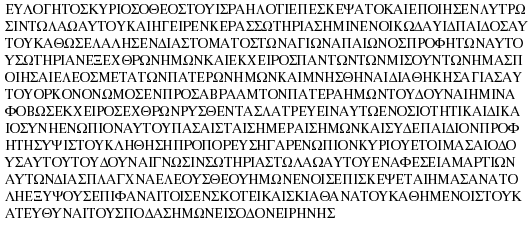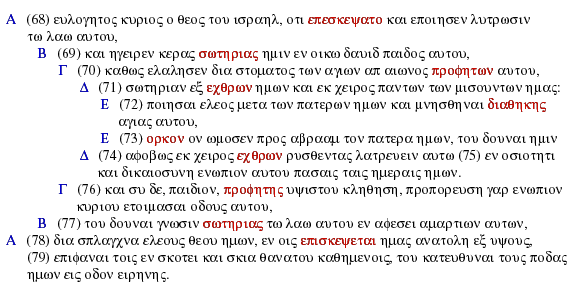  
"I Shit My Pants":
Spontaneous Ancient Literary Structure in Modern Colloquial Speech
Part IV: Chiasmus
chi·as·mus (ki-AZ'-muss) n.
Derived from the Greek chiasmos, from chiazein (to mark with a chi, or X)
A figure of speech consisting of an inversion of the relationship between parallel phrase elements (e.g., Mae West's "It's not the men in your life; it's the life in your men.")
Though some would try to use their presence in a given work as proof of its extra-natural origin (such as Mormon proselytizers purporting to discover evidentiary support for their claims of a supernatural origin for the so-called "Book of Mormon", a pastiche fiction cobbled together by a certain "Joseph Smith," a minor nineteenth-century upstate New York peeper and mountebank), literary tropes and rhetorical figures of speech -- from whatever source derived -- are in evidence among the oldest writings known to us. Though the phenomenon is not limited to writings thought to be sacred, it was largely the work of certain mainly Protestant scholars -- we might mention in particular Albertus Bengel (Gnomon Novi Testamenti, 1742), Thomas E. Boys (fl. ca. 1820-30), Richard Baillie Roe, Robert Lowth (Lectures on the Sacred Poetry of the Hebrews, 1787), John Jebb of Limerick (Sacred Literature, 1820), and Dr. E. W. Bullinger (1837-1913) -- that served as the leading lamps of the explication of most types of figurative speech in the ancient literature. Chief among these figures (if commonness of occurrence is the measure) would have to be the various forms of chiasmus (sometimes referred to in the scholarly literature as antimetabole, epanodos, or simply "correspondences," "structures," or "parallelism").
Chiasmus takes its name from the Greek letter chi, which looks like our letter X. Why the letters of our modern English alphabet have no formal names remains a mystery, but the modern world is nevertheless well familiar with the chi, of course, from other contexts, such as the following:

In literature, however, the chi finds expression in the chiasmus, which received its name from one or both of two posited causes. (1) In its simplest form, when diagrammed with lines drawn between its elements, the lines of a chiasmus form a chi, such as in the following example from Chaucer's The Book of the Duchess (line 597):

(2) Alternatively, it is possible that the figure received its name from the half-chi that is formed when the chiasmus is diagrammed in its classic ABBA format, as follows:

Whatever may prove to be the origin of its name, what needs little proof is that one can find chiastic structures in the works of nearly every major literary figure in occidental literature, from Homer (Odyssey, 11.170) to Milton ("Be still, thou waves, and thou deeps, peace") to Shakespeare ("Moor, she was chaste; she lov'd thee, cruel Moor") to Goethe ("Die Kunst ist lang, und kurz ist unser Leben") to Horace ("Integer vitae scelerisque purus") and back to Homer again.
Chiasmus can take many forms -- transpositional, alternating, or inverse, e.g., to name but a few -- but its classic form is undoubtedly the ABBA pattern -- chiasmus inversus.
The following example of an extended chiasmus inversus with ten members demonstrates how the Hebrew song of Zacharias, as it has come down to us in its Greek form, would have appeared on papyri:

Homeric Greek, of course, was written down in the style Boustrophedon, which meant, roughly, "as the ox plows" -- that is to say, it alternates direction with every line; however, this practice had been abandoned long before even Attic Greek, and longer still before Koine Greek. Papyrus being at a premium in the ancient world, the Greeks wisely did not employ spaces between words, making it difficult for modern eyes to discern the structure of literary compositions. Re-formatted for English-speaking eyes and analyzed into its major themes, however, Zacharias's song falls well and easily into a form instantly recognizable as an extended ABBA type of chiasmus inversus:

Summarized by its major themes (represented by the words in red, above), the chiasmus appears as follows:
A Visitation.
B Salvation.
C Prophets.
D Enemies.
E Covenant.
E Oath.
D Enemies.
C Prophet.
B Salvation.
A Visitation.
We could break down this example into many more members and submembers, to show the different variations of chiasmus employed therein, but we can accept as given the ancient use of the chiasmus to be well established. What we now must demonstrate, however, is that complex or sophisticated literary and rhetorical figurative speech can be unknowingly employed by modern speakers of colloquial English.
  
|

